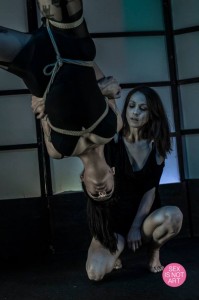Competent shibari: Hip harness
An analysis of a well-known tutorial with our improved version of this tie
Competent Shibari
In this tutorial, we tie and analyse a hip harness from a well-known shibari manual. We then create our own version to overcome the perceived deficiencies in effectiveness and aesthetics.
Other than simple decoration, unless used with a crotch rope or other enhancement, the only real function of a hip-harness is as a solid base for suspension. In our opion, there's more to shibari that mere decoration. Nevertheless, it should also be beautiful and flatter the person in the rope. In our opinion, the first example does not fulfil the above criteria as will become apparent in the video. As I always like to put it, usually in reference to takate-kote ties (TK/gote/box-tie): "It's not enough to look like a plane, it needs to fly like one too". Correct engineering is not to be ignored. The original example fails in the egineering making it unsuitable for suspension. We will demonstrate how to easily overcome this and point out how the ingredients should be properly used.
Doing it right
In the second video, Nina shows a more typical version to address some of the issues in the original. This version, and the optional tutorial for 'Nina's hip-harness', are constructed using only simple ingredients that you already know: Single column tie and a few frictions. Pay attention to how we use these ingredients to create structure and solutions. For further study, see also Osaka Dan's 'Hip-harness and futo-momo'.
20% off Nina's hip-harness tutorial
As Nina's existing hip-harness tutorial offers a far more solid option for suspension, it was decided there was no point in re-creating these instructions in this tutorial. Instead, we are offering a 20% discount on the purchase and subscription versions of this very functional tie when you sign up to this 'Competent Shibari' tutorial.
Your Instructor

Nina Russ
Nina Russ is a London based, shibari performer, rope artist and educator. She became student of Esinem in 2011 and their collaboration gave birth to BOUND shibari night (2012) and ShibariClasses (2015). She had also the fortune to participate at workshops with different Japanese shibari masters, like: Kazami Ranki, Yukimura Haruki, Kinoko Hajime.
She has performed internationally, most notably at the London Festival of the Art of Japanese Rope Bondage and RopeFest in St.Petersburg. In addition, she participates in numerous artistic, fashion collaborations and local performances. Her passion for rope has lead her on a route of discovery of concepts, philosophy, aesthetics and benefits behind this Japanese discipline.
She sees shibari as an art form which creates deep connection between the participants and also aids personal development. Due to its martial arts roots, it brings self-discipline, efficiency, effectiveness and, thus, growth in confidence and awareness. She believes these skills allow a greater focus on the most important aspects: you, your partner and your shared experience.
Rope is simply a means of communication. She wants you to discover through her tying, the language of rope, which speaks directly to the mind and body.